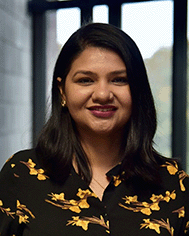Nanoscale Horizons Emerging Investigator Series: Dr Shalini Singh, University of Limerick, Ireland
Abstract
Our Emerging Investigator Series features exceptional work by early-career nanoscience and nanotechnology researchers. Read Shalini Singh's Emerging Investigator Series article ‘Colloidal synthesis of the mixed ionic–electronic conducting NaSbS2 nanocrystals’ (https://doi.org/10.1039/D3NH00097D) and read more about her in the interview below.
Dr Shalini Singh is an associate professor in chemistry at the University of Limerick. She received her PhD in chemistry from the University of Limerick in 2016 and was an FWO Postdoctoral Fellow at Ghent University, Belgium, until 2019. Since 2020, she has been leading the Functional Nanomaterial Research Group at the University of Limerick. Her research interests are focused on the development of multifunctional nanocrystals for energy conversion and storage applications.
Read Shalini Singh's Emerging Investigator Series article ‘Colloidal synthesis of the mixed ionic–electronic conducting NaSbS 2 nanocrystals’ ( https://doi.org/10.1039/D3NH00097D ) and read more about her in the interview below:
NH: Your recent Nanoscale Horizons Communication reports a colloidal hot injection approach for the synthesis of mixed ionic–electronic conducting NaSbS 2 nanocrystals. How has your research evolved from your first article to this most recent article and where do you see your research going in future?
SS: My first publication was on nanocomposite polymeric anion exchange membranes. It was before I started my PhD and started my venture in colloidal nanocrystals research. Over the years, my research has evolved from polymers to colloidal nanocrystals synthesis and applications. I gained expertise in synthesis, surface chemistry and application of colloidal nanocrystals in optoelectronics, thermoelectrics, electrocatalysts and batteries. Now, I am working towards designing sustainable nanocrystals to replace critical raw materials in technological applications. The future of my work will be focusing on atomically precise control over nanocrystal design and consolidating colloidal chemistry as a synthesis platform for designer materials.
NH: How do you feel about Nanoscale Horizons as a place to publish research on this topic?
SS: It is my first publication in Nanoscale Horizons. I have been reading the articles here from the time the journal was launched, and I am aware of the cutting-edge research published here. As we were developing a new colloidal nanomaterial and demonstrating its dual ionic–electronic conductivity, Nanoscale Horizons was certainly our first choice to go to!
NH: What aspect of your work are you most excited about at the moment?
SS: At the moment, in my research group we are linking machine learning, computational chemistry and experimental findings together to develop new multifunctional material compositions with sustainable and benign compositions. It is exciting to see the development of new materials as nanocrystals which have only been predicted computationally. Also, the ability to engineer the phase and compositions of these brand-new materials to tune their optoelectronic properties is something that excites me the most.
NH: In your opinion, what are the most important questions to be asked/answered in this field of research?
SS: In the field of nanocrystals, we have seen amazing progress in the last two decades with some of the most recent being the success of highly efficient lead halide perovskites in optoelectronics. But the future is dependent on sustainability, something that we all have learned from the diminishing level of fossil fuels. So, I think if we can design materials that can mimic the structure and properties of perovskites but with sustainable, nontoxic materials, it could be possible to create the next generation of sustainable energy conversion devices based on nanocrystals.
NH: What do you find most challenging about your research?
SS: There is still a lack of fundamental understanding of the underlying concepts on surface, structure, and crystallization in colloidal nanocrystals when synthesising new semiconductor nanocrystals with designer and tunable properties. These missing links usually hamper the development of reproducible and scalable ways to synthesize, process, and integrate these new materials in applications. Addressing these fundamental challenges will be important to create a platform technology for an easier lab-to-fab transition of novel nanomaterials.
NH: In which upcoming conferences or events may our readers meet you?
SS: I will be going to ACS Spring 2024, then the GRC on colloidal nanocrystals in 2024. I am also organising a symposium at NanoGe fall 2024 so you will also find me there.
NH: How do you spend your spare time?
SS: I have recently started taking special interest in cooking as I am a mother of a toddler. In my spare time, I am designing and experimenting with new healthy recipes with the hope that he will love it and eat it.
NH: Can you share one piece of career-related advice or wisdom with other early career scientists?
SS: I would advise them to find a mentor early in your career who would love to see your growth as a scientist. This career path has a lot of uncertainties along the way and having someone who has experience and is invested in your career as much as you are helps to navigate through it and build your confidence in the long run.
| This journal is © The Royal Society of Chemistry 2024 |

